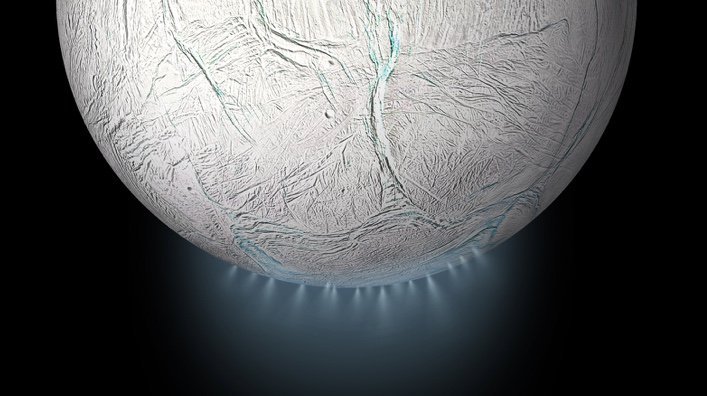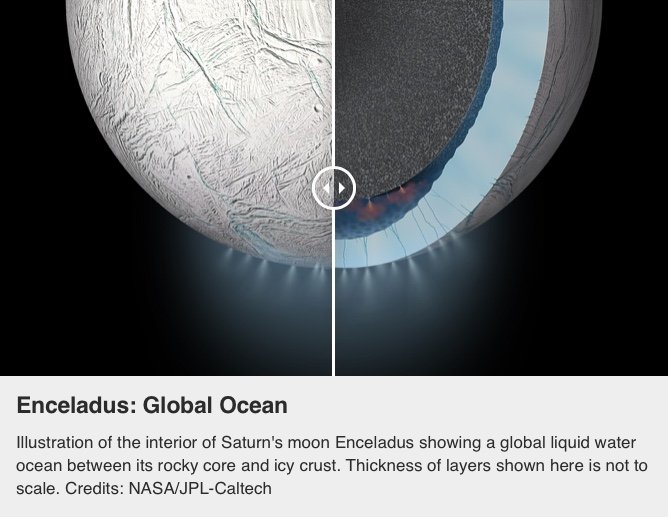
The same early life found abundantly on Earth may be living on Saturn’s moon, Enceladus.
It is a commonly accepted theory that life started on Earth in the form of tiny, microbial animals which are found even today deep in our oceans. These include bacteria, and archaea which lack a cell nucleus or other membrane-bound cellular structures, yet are still biologically complex, including the ability to create protein-producing DNA.
The earliest evidence for life on Earth comes from fossilized mats of cyanobacteria called stromatolites in Greenland that are about 3.7 billion years old.
These tiny creatures are so profuse, they outnumber macroscopic life – including mammals, fish, reptiles, and every other form of “life” that we are used to seeing with the naked eye. Without microbes, life as we know it on Earth would likely never have formed.
Curiously, scientists are now seeing signs of this same type of early life on one of Saturn’s moons – confirming that alien life indeed exists in our solar system.
Saturn’s moon, Enceladus, has been considered a hot spot for possible extraterrestrial life by researchers from NASA, and other institutions for decades.
Interest in looking for alien life on Saturn’s moon ramped up just after NASA’s Cassini satellite discovered that plumes sprouting up from Enceladus’s surface contained water and other gases. There are likely hot vents coming up from underground oceans which may spray gaseous matter and watery microbial life – just like on ancient Earth.

Scientists tried to reproduce the conditions on one of Saturn’s moons and found that it could, perhaps, be hospitable to life.
Only recently scientists postulated that the large amounts of methane on Enceladus showed the most promising evidence of alien life, acting as proof of microbial or biological activity.
Moreover, there are hardy forms of bacteria on Earth that could withstand the extremely cold weather of Saturn’s moon. These super strong microbes could be eating hydrogen that is produced by the interactions between water and rock just beneath Enceladus’ surface. The biological by-product of microbes eating hydrogen is methane.
Simon Rittmann, of the Department of Ecogenomics and Systems Biology at the University of Vienna in Austria, said of one study which measured methane on Enceladus,
“We were able to show that, under putative Enceladus conditions, biological methane production occurs in the lab. Hence some of the methane detected on Enceladus could in principle be of biological origin.”
Further study suggests that the heated vents spewing certain elements into frigid waters on an icy ocean that covers the moon’s entire surface could be creating a chemical soup that supports life.
The proposed single-celled microorganisms are thought to live in extreme conditions just like the same forms of life on Earth – in places like hot geysers, the seafloor, and oil wells. They eat carbon dioxide and release methane.
“Under these conditions, life could exist,” said researcher Simon Rittmann, who led the experiment as part of the University of Vienna’s division of archaea biology and ecogenomics.
NASA’s Cassini project, called one of the most ambitious efforts in planetary space exploration, did not reportedly contain the right surveying tools to confirm if there is microbial life on Saturn’s moon. However, scientists suggest that ice samples taken from the South Pole, as it comes out of the rocky crust, would likely contain all the proof we’d need to confirm alien life on Enceladus.
Enceladus discoveries have changed the direction of planetary science. – Linda Spilker, Cassini Project Scientist
It is clear the Cassini project is revealing a lot about Saturn, and its moons, but that much more is yet to be revealed. One of NASA’s top engineers has even stated that alien spaceships are hiding in Saturn’s rings, but even without confirmation of claims like these, the verification of microbial life on Saturn’s moon would mean that many more places in our Galaxy are likely to harbor life which resembles what we see here on our own planet.

Cassini images of Saturn’s moon Enceladus backlit by the sun show the fountain-like sources of the fine spray of material that towers over the south polar region. Credit: NASA.gov.
Seth Shostak, a senior astronomer at the Search for Extraterrestrial Intelligence (SETI) Institute, beleives that there are many places near us where some form of microbial life is likely to exist.
“There are at least seven other places in our own solar system, so kind of next door places you could get to with a rocket, that could have microbial life,” Shostak said.
Shostack also believes that we’ll possibly spot these alien microbial life sooner than we could find intelligent extraterrestrial life. He states that the most logical places to look are:
Mars
Three of Jupiter’s moons (Europa, Ganymede, and Callisto)
Saturn’s moons (Titan and Enceladus)
Pluto
When asked what conditions would be needed to support microbial life Shostak says, “You have something that gives you food, fundamentally, and the opportunity to create life, which after all is just organic chemistry.” Special thanks go to The Mind Unleashed for providing this content, thanks for your interest.
👽
A weird part of me still kinda hopes for an alien invasion in our lifetime.
touché